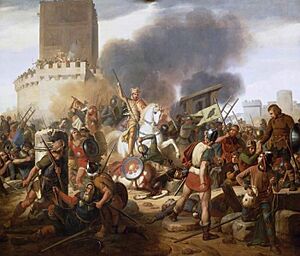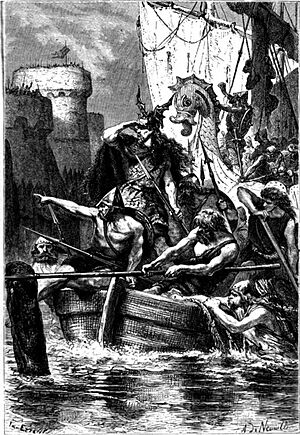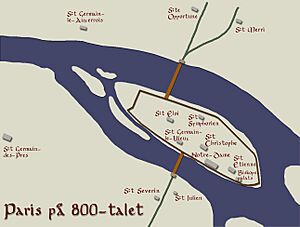Siege of Paris (885–886) facts for kids
Quick facts for kids Siege of Paris (885–886) |
|||||||
|---|---|---|---|---|---|---|---|
| Part of the Viking expansion | |||||||
 Count Odo defends Paris against the Norsemen, romantic painting by Jean-Victor Schnetz (1837), Galerie des Batailles |
|||||||
|
|||||||
| Belligerents | |||||||
| Vikings | West Francia | ||||||
| Commanders and leaders | |||||||
| Sigfred Sinric Rollo |
Odo, Count of Paris Gozlin, Bishop of Paris Henry of Saxony † Charles the Fat |
||||||
| Strength | |||||||
| Initially 300–700 ships, 30,000–40,000 men (high-end, Abbo Cernuus); a majority sailed further upriver in February; Sigfred's contingent left in April | Initially 200 men-at-arms (Abbo Cernuus); gained reinforcements during the summer; Charles the Fat arrived with his army in October | ||||||
The Siege of Paris in 885–886 was a major event during the Viking raids on the Seine River. This happened in a kingdom called West Francia, which is now part of France. It was a very important moment for Charles the Fat, who was the emperor at the time. The siege also showed how important Paris was as a city. We know a lot about this event from a poem written by someone who was there, named Abbo Cernuus.
Hundreds of Viking ships, possibly carrying thousands of warriors, arrived near Paris in late November 885. They wanted money from the city. But Odo, the Count of Paris, refused to pay. He only had a few hundred soldiers to defend the city. The Vikings used large machines to attack the city walls. But they could not break through, even after many days of fighting. The siege lasted for months, but the main attacks stopped after the first few days. Many Vikings left Paris to raid other areas further up the river. The Vikings tried one last time to take the city in the summer, but they failed. Finally, in October, Emperor Charles the Fat arrived with his army.
The people of Paris were very frustrated. Charles did not attack the Vikings. Instead, he let them sail further up the Seine River to raid Burgundy. He also promised them 700 livres (about 257 kg) of silver. Odo was very unhappy with this decision. When Charles died in 888, Odo was chosen as the new king. He was the first king who was not from the Carolingian family.
Why the Vikings Attacked Paris
Paris had been attacked by Vikings before. They first reached Paris in 845 and looted the city. They attacked three more times in the 860s. They would only leave after getting enough treasure or bribes. In 864, new bridges were built across the Seine in Paris. These bridges were very important during the siege of 885. They helped block the Viking ships.
The area around Paris was ruled by the Duke of Francia, who was also the Count of Paris. This was first Robert the Strong. He started making Paris stronger and fought the Vikings often. His son, Odo, took over after him. But the power of the king was getting weaker. Paris kept building up its defenses, not because the king ordered it, but because the local leaders wanted to protect their city.
West Francia had many kings who ruled for only a short time after 877. This changed in 884 when Charles the Fat became king. He was already king of Germany and Italy. People hoped he would reunite the old empire of Charlemagne. Even though the Franks had won a big battle against the Vikings in 881, the Vikings launched their biggest attack on Paris in 885. This was just one year after Charles became king.
The Siege Begins
In 885, Vikings led by Sigfred and Sinric sailed towards West Francia again. They had already raided other parts of the country. Sigfred asked Charles for money, but Charles said no. So, Sigfred led about 700 ships up the Seine River. Some people say there were as many as 30,000 or 40,000 Viking warriors. This number comes from Abbo Cernuus, who saw the siege. But historians think Abbo greatly exaggerated the numbers. Some historians believe there were closer to 300 ships.
The Franks tried to stop the Vikings from sailing up the Seine. But the Vikings managed to reach Paris. At that time, Paris was a town on an island called Île de la Cité. It was important because its two low bridges could block ships. Even the shallow Viking ships could not pass. Odo, Count of Paris, got ready for the Vikings. He built two towers to guard each bridge. He only had about 200 soldiers. But he led the defense with Gozlin, the Bishop of Paris. Gozlin was known as a "fighting bishop." Odo also had help from his brother, Robert.

The Vikings arrived in Paris on November 24 or 25, 885. They first asked for money from the Franks. When they were refused, they started the siege. On November 26, the Vikings attacked the northeast tower. They used machines like ballistae (giant crossbows) and catapults. The Parisians fought back with hot wax and tar. All Viking attacks that day were stopped. During the night, the Parisians built another level on the tower.
On November 27, the Vikings tried again. They used mining, battering rams, and fire. But it did not work. Bishop Gozlin joined the fight with a bow and an axe. He put a cross on the defenses and encouraged the people. His brother Ebles also fought. The Vikings pulled back after these failed attacks. They built a camp on the riverbank using stone. They also started building more siege machines. In a new attack, they shot many grenades at the city. They sent a ship towards the bridge and attacked by land with three groups. They surrounded the tower at the bridge, trying to clear the river. While trying to burn the bridge, they also attacked the city with their machines.
Months of Fighting
For two months, the Vikings kept up the siege. They dug trenches and found food from the land. In January 886, they tried to fill the shallow parts of the river with dirt and plants. They wanted to get around the tower. They worked on this for two days. On the third day, they set three ships on fire. They sent them towards the wooden bridge. The burning ships sank before they could burn the bridge. But the bridge was still weakened.
On February 6, heavy rains caused the river to flood. The bridge supports broke. The bridge was gone, and the northeast tower was now alone. Only twelve defenders were inside. The Vikings asked them to give up, but they refused. All twelve were killed.
The Vikings left some forces around Paris. But many went to raid other cities like Le Mans and Chartres. Odo managed to get some men through the Viking lines. They went to Italy to ask Charles the Fat for help. Henry, Count of Saxony, Charles's main general, marched towards Paris. His soldiers were tired from marching in winter. They made one small attack in February, then retreated. The people inside Paris sometimes went out to get supplies.
The Vikings' spirits were low. Sigfred asked for sixty pounds of silver and left the siege in April. Another Viking leader, Rollo, stayed with his men. In May, a disease spread among the Parisians, and Bishop Gozlin died. Odo then secretly went through Viking territory to ask Charles for help again. Charles agreed. Odo fought his way back into Paris. Charles and Henry of Saxony marched north. Henry died after falling into a Viking ditch, where he was captured and killed.
That summer, the Vikings made one last try to take the city. But they were pushed back. The emperor's army arrived in October and scattered the Vikings. Charles surrounded Rollo and his army. But Charles did not want to fight. He let the Vikings sail up the Seine River to raid Burgundy. Burgundy was rebelling against Charles at the time. When the Vikings left France the next spring, Charles gave them 700 pounds of silver, as he had promised. This was about 257 kilograms.
What Happened Next
The people of Paris and Odo did not let the Vikings sail back down the Seine. The Vikings had to drag their boats over land to the Marne River to leave the country. When Charles the Fat died in 888, the French chose Odo as their new king. Odo's brother, Robert I of France, also became king later. He ruled against the Carolingian king, Charles the Simple.
For a long time, Odo's family, called the Robertians, held the crown. They were important leaders in West Francia. But their power was not always strong. Many smaller local rulers challenged their authority. In 987, the leaders of West Francia chose Robert I's grandson, Hugh Capet, as king.
The Viking invasion and other raids destroyed much of the city's buildings on the Left Bank of the Seine. This area eventually became farmland. The Right Bank was mostly saved from looting. Because of this, Paris later grew more on the Right Bank.


